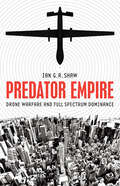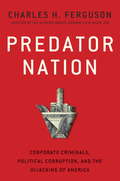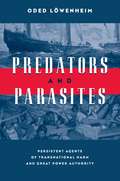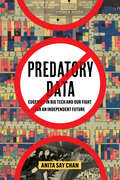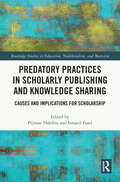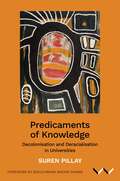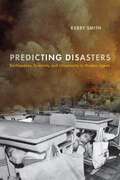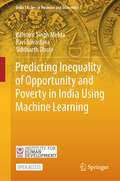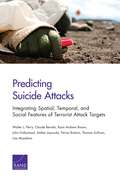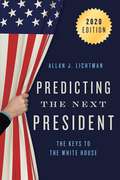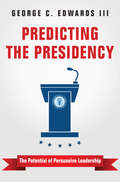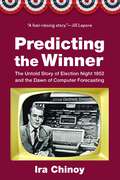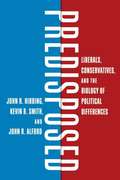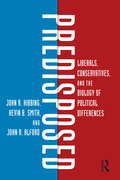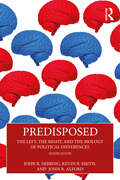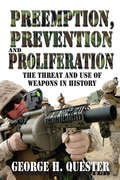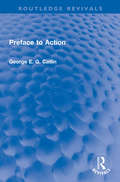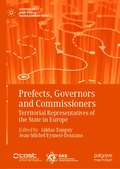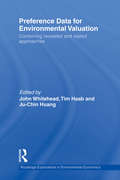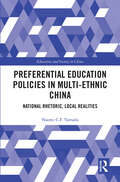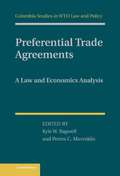- Table View
- List View
Predator Empire: Drone Warfare and Full Spectrum Dominance
by Ian G. ShawWhat does it mean for human beings to exist in an era of dronified state violence? How can we understand the rise of robotic systems of power and domination? Focusing on U.S. drone warfare and its broader implications as no other book has to date, Predator Empire argues that we are witnessing a transition from a labor-intensive &“American empire&” to a machine-intensive &“Predator Empire.&” Moving from the Vietnam War to the War on Terror and beyond, Ian G. R. Shaw reveals how changes in military strategy, domestic policing, and state surveillance have come together to enclose our planet in a robotic system of control. The rise of drones presents a series of &“existential crises,&” he suggests, that are reengineering not only spaces of violence but also the character of the modern state. Positioning drone warfare as part of a much longer project to watch and enclose the human species, he shows that for decades—centuries even—human existence has slowly but surely been brought within the artificial worlds of &“technological civilization.&” Instead of incarcerating us in prisons or colonizing territory directly, the Predator Empire locks us inside a worldwide system of electromagnetic enclosure—in which democratic ideals give way to a system of totalitarian control, a machinic &“rule by Nobody.&” As accessibly written as it is theoretically ambitious, Predator Empire provides up-to-date information about U.S. drone warfare, as well as an in-depth history of the rise of drones.
Predator Nation: Corporate Criminals, Political Corruption, and the Hijacking of America
by Charles H. FergusonCharles H. Ferguson, who electrified the world with his Oscar-winning documentary Inside Job, now explains how a predator elite took over the country, step by step, and he exposes the networks of academic, financial, and political influence, in all recent administrations, that prepared the predators' path to conquest. Over the last several decades, the United States has undergone one of the most radical social and economic transformations in its history. · Finance has become America's dominant industry, while manufacturing, even for high technology industries, has nearly disappeared. · The financial sector has become increasingly criminalized, with the widespread fraud that caused the housing bubble going completely unpunished. · Federal tax collections as a share of GDP are at their lowest level in sixty years, with the wealthy and highly profitable corporations enjoying the greatest tax reductions. · Most shockingly, the United States, so long the beacon of opportunity for the ambitious poor, has become one of the world's most unequal and unfair societies. If you're smart and a hard worker, but your parents aren't rich, you're now better off being born in Munich, Germany or in Singapore than in Cleveland, Ohio or New York. This radical shift did not happen by accident. Ferguson shows how, since the Reagan administration in the 1980s, both major political parties have become captives of the moneyed elite. It was the Clinton administration that dismantled the regulatory controls that protected the average citizen from avaricious financiers. It was the Bush team that destroyed the federal revenue base with its grotesquely skewed tax cuts for the rich. And it is the Obama White House that has allowed financial criminals to continue to operate unchecked, even after supposed "reforms" installed after the collapse of 2008. Predator Nation reveals how once-revered figures like Alan Greenspan and Larry Summers became mere courtiers to the elite. Based on many newly released court filings, it details the extent of the crimes--there is no other word--committed in the frenzied chase for wealth that caused the financial crisis. And, finally, it lays out a plan of action for how we might take back our country and the American dream.
Predator: The Secret Origins of the Drone Revolution
by Richard WhittleThe untold story of the birth of the Predator drone, a wonder weapon that transformed the American military, reshaped modern warfare, and sparked a revolution in aviationThe creation of the first weapon in history whose operators can stalk and kill an enemy on the other side of the globe was far more than clever engineering. As Richard Whittle shows in Predator, it was one of the most profound developments in the history of military and aerospace technology.Once considered fragile toys, drones were long thought to be of limited utility. The Predator itself was resisted at nearly every turn by the military establishment, but a few iconoclasts refused to see this new technology smothered at birth. The remarkable cast of characters responsible for developing the Predator includes a former Israeli inventor who turned his Los Angeles garage into a drone laboratory, two billionaire brothers marketing a futuristic weapon to help combat Communism, a pair of fighter pilots willing to buck their white-scarf fraternity, a cunning Pentagon operator nicknamed "Snake," and a secretive Air Force organization known as Big Safari. When an Air Force team unleashed the first lethal drone strikes in 2001 for the CIA, the military's view of drones changed nearly overnight.Based on five years of research and hundreds of interviews, Predator reveals the dramatic inside story of the creation of a revolutionary weapon that forever changed the way we wage war and opened the door to a new age in aviation.
Predators and Parasites: Persistent Agents of Transnational Harm and Great Power Authority
by Oded LowenheimLöwenheim (Hebrew U. of Jerusalem) defines persistent agents of transnational harm (PATHs) as private groups, organizations, or networks that operate across state borders and deliberately cause for facilitate harm in the pursuit of their interests; polluters and tobacco dealers are among them. He explores why Great Powers counter their practices, but his examples are limited to the Barbary Pirates and anyone the US administration has called out after the 9/11 attacks. Annotation ©2007 Book News, Inc. , Portland, OR (booknews. com)
Predatory Data: Eugenics in Big Tech and Our Fight for an Independent Future
by Anita Say ChanThe first book to draw a direct line between the datafication and prediction techniques of past eugenicists and today's often violent and extractive "big data" regimes. Predatory Data illuminates the throughline between the nineteenth century's anti-immigration and eugenics movements and our sprawling systems of techno-surveillance and algorithmic discrimination. With this book, Anita Say Chan offers a historical, globally multisited analysis of the relations of dispossession, misrecognition, and segregation expanded by dominant knowledge institutions in the Age of Big Data. While technological advancement has a tendency to feel inevitable, it always has a history, including efforts to chart a path for alternative futures and the important parallel story of defiant refusal and liberatory activism. Chan explores how more than a century ago, feminist, immigrant, and other minoritized actors refused dominant institutional research norms and worked to develop alternative data practices whose methods and traditions continue to reverberate through global justice-based data initiatives today. Looking to the past to shape our future, this book charts a path for an alternative historical consciousness grounded in the pursuit of global justice. A free ebook version of this title is available through Luminos, University of California Press’s Open Access publishing program. Visit www.luminosoa.org to learn more.
Predatory Practices in Scholarly Publishing and Knowledge Sharing: Causes and Implications for Scholarship (Routledge Studies in Education, Neoliberalism, and Marxism)
by Pejman Habibie Ismaeil FazelThis volume offers comprehensive examination of “predatory” practices in scholarly publishing, and highlights emergent issues around predatory journals, Open Access (OA), and scam conferences. Chapters engage multiple methodologies, including corpus, discourse, and genre analysis, as well as historical and autoethnographic approaches to offer in-depth, empirical analyses of the causes, practices, and implications of predatory practices for scholars. Contributors span a broad range of disciplines and geolocations, presenting a diverse range of perspectives. The volume also outlines effective initiatives for the identification of predatory practices and considers steps to increase understanding of viable publishing options. Providing a needed exploration of predatory research practices, this book will appeal to scholars and researchers with interests in higher education, publishing, and communication ethics.
Predatory Practices in Scholarly Publishing and Knowledge Sharing: Causes and Implications for Scholarship (Routledge Studies in Education, Neoliberalism, and Marxism)
by Pejman Habibie Ismaeil FazelThis volume offers comprehensive examination of “predatory” practices in scholarly publishing, and highlights emergent issues around predatory journals, Open Access (OA), and scam conferences.Chapters engage multiple methodologies, including corpus, discourse, and genre analysis, as well as historical and autoethnographic approaches to offer in-depth, empirical analyses of the causes, practices, and implications of predatory practices for scholars. Contributors span a broad range of disciplines and geolocations, presenting a diverse range of perspectives. The volume also outlines effective initiatives for the identification of predatory practices and considers steps to increase understanding of viable publishing options.Providing a needed exploration of predatory research practices, this book will appeal to scholars and researchers with interests in higher education, publishing, and communication ethics.
Predicaments of Knowledge: Decolonisation and Deracialisation in Universities
by Suren PillayPredicaments of Knowledge explores the difficult questions South African universities face after apartheid: Is there a difference between Africanising a university and decolonising a university? What about differences between deracialising and decolonising the curricula taught at universities across disciplines? Through a range of reflections on race, language, colonial, postcolonial and decolonial knowledge projects from Africa and Latin America, this book explores the pitfalls and possibilities that face a post-apartheid generation inventing the future of knowledge. The distinctions between Africanisation, decolonisation and deracialisation are often conflated in the political demands put to universities. Suren Pillay emphasises all three as important but distinct imperatives. If an intervention is undertaken with the aim of decolonising the university while actually addressing deracialisation, it can undermine the effort to decolonise. Similarly, if an initiative to Africanise the university does not address decolonisation, both processes can be undermined. Drawing on more than two and a half decades of the author’s participation in these debates, these essays aim to intervene in and elucidate questions and predicaments, rather than offering blue prints; they are dialogical in spirit even when polemical in tone. In conversation with existing continental African and Latin American experiences, they offer incisive reflections on current South African debates.
Predicting Disasters: Earthquakes, Scientists, and Uncertainty in Modern Japan (Critical Studies in Risk and Disaster)
by Kerry SmithJapan is a place where powerful earthquakes have occurred more frequently and have caused more harm in the modern era than they have in all but a handful of other locations on the planet. In the twentieth century alone, earthquake disasters in Japan took almost as many lives as they had in all of the country’s recorded history up to that point. Predicting Disasters is the first English-language book to explore how scientists convinced policy makers and the public in postwar Japan that catastrophic earthquakes were coming, and the first to show why earthquake prediction has played such a central role in Japan’s efforts to prepare for a dangerous future ever since.Kerry Smith shows how, in the twentieth century, scientists struggled to make large-scale earthquake disasters legible to the public and to policy makers as significant threats to Japan’s future and as phenomena that could be anticipated and prepared for. Smith also explains why understanding those struggles matters. Disasters, Smith contends, belong alongside more familiar topics of analysis in modern Japanese history—such as economic growth and its impacts, political crises and popular protest, and even the legacies of the war—for the work they do in helping us better understand how the past has influenced beliefs about Japan’s possible futures, and how beliefs about the future shape the present.Predicting Disasters makes relevant elements of Japan’s past more accessible to readers interested in the histories of disaster and scientific communities, as well as to those who want to gain a better understanding of the risk and uncertainty surrounding natural phenomena.
Predicting Inequality of Opportunity and Poverty in India Using Machine Learning (India Studies in Business and Economics)
by Balwant Singh Mehta Ravi Srivastava Siddharth DhoteThis open-access book combines traditional economic methods with newer machine learning techniques such as regression trees and random forests to analyse data and provide an in-depth analysis of inequality of opportunity and poverty in India. Using data from national surveys and unique sources like night-time satellite images and location data of points of interest, it explores different aspects of inequality and poverty. The book adopts a unique interdisciplinary approach, blending theories and methods from sociology, economics, geography, anthropology, and computer science to explore three key aspects of human well-being: income, health, and education, focusing on regional disparities. It aims to offer practical insights for policymakers and researchers who want to address social and economic inequalities in India.
Predicting Suicide Attacks: Integrating Spatial, Temporal, and Social Features of Terrorist Attack Targets
by Walter L. Perry Claude Berrebi Thomas Sullivan John Hollywood Parisa Roshan Ryan Andrew Brown Amber Jaycocks Lisa MiyashiroAs part of an exploration of ways to predict what determines the targets of suicide attacks, RAND conducted a proof-of-principle analysis of whether adding sociocultural, political, economic, and demographic factors would enhance the predictive ability of a methodology that focused on geospatial features. This test case focused on terrorist bombing incidents in Israel, but the findings indicate that the methodology merits further exploration.
Predicting the Next President: The Keys To The White House
by Allan J. LichtmanIn the days after Donald Trump’s unexpected victory on election night 2016, The New York Times, CNN, and other leading media outlets reached out to one of the few pundits who had correctly predicted the outcome, Allan J. Lichtman. While many election forecasters base their findings exclusively on public opinion polls, Lichtman looks at the underlying fundamentals that have driven every presidential election since 1860. Using his 13 historical factors or “keys” (four political, seven performance, and two personality), that determine the outcome of presidential elections, Lichtman had been predicting Trump’s win since September 2016. In the updated 2020 edition of this classic text, Lichtman applies the keys to every presidential election since 1860 and shows readers the current state of the 2020 race. In doing so, he dispels much of the mystery behind electoral politics and challenges many traditional assumptions. An indispensable resource for political junkies!
Predicting the Presidency: The Potential of Persuasive Leadership
by George C. Edwards IIIMillions of Americans—including many experienced politicians—viewed Barack Obama through a prism of high expectations, based on a belief in the power of presidential persuasion. Yet many who were inspired by candidate Obama were disappointed in what he was able to accomplish once in the White House. They could not understand why he often was unable to leverage his position and political skills to move the public and Congress to support his initiatives. Predicting the Presidency explains why Obama had such difficulty bringing about the change he promised, and challenges the conventional wisdom about presidential leadership. In this incisive book, George Edwards shows how we can ask a few fundamental questions about the context of a presidency—the president's strategic position or opportunity structure—and use the answers to predict a president's success in winning support for his initiatives. If presidential success is largely determined by a president's strategic position, what role does persuasion play? Almost every president finds that a significant segment of the public and his fellow partisans in Congress are predisposed to follow his lead. Others may support the White House out of self-interest. Edwards explores the possibilities of the president exploiting such support, providing a more realistic view of the potential of presidential persuasion. Written by a leading presidential scholar, Predicting the Presidency sheds new light on the limitations and opportunities of presidential leadership.
Predicting the Unthinkable, Anticipating the Impossible: From the Fall of the Berlin Wall to America in the New Century
by Georgie Anne GeyerIn the 1980s, most Americans scoffed at the idea that the Communist empire could collapse - but Georgie Anne Geyer was already outlining that probability. In the 1990s, the world was stunned by wars that raged across post-Yugoslavia and their viciousness - but Geyer on a trip to Belgrade in 1989, interviewed top officials and anticipated the conflicts. When 9/11 occurred, she used common sense and said, 'This was inevitable - the terrorists had already attacked the World Trade Center in 1993 and criminals always return to the scene of the crime.'Geyer argues that while the United States was being praised everywhere during this era of 'indispensable power' as the 'greatest power the world has known,' it actually had started on the road to decline. It had won the Cold War, but had immediately embarked upon more Vietnam-like small wars of tremendous cost in Iraq and Afghanistan. Across the board, it was no longer paying its way, while its domestic culture was being vulgarized at every turn.This book explains how, when, and where these declines happened. Geyer studies the history of nations and of peoples, observes human nature, particularly as influenced by religion and ideology; and is a close analyst of the acts of men and women when they perceive they have been humiliated by others or by history. She warns Americans and journalists that we must anticipate the changes in the world before they are upon us and that we must employ predictions to strengthen our nation and its principles.
Predicting the Winner: The Untold Story of Election Night 1952 and the Dawn of Computer Forecasting
by Ira ChinoyThe history of American elections changed profoundly on the night of November 4, 1952. An outside-the-box approach to predicting winners from early returns with new tools—computers—was launched live and untested on the newest medium for news: television. Like exhibits in a freak show, computers were referred to as &“electronic brains&” and &“mechanical monsters.&” Yet this innovation would help fuel an obsession with numbers as a way of understanding and shaping politics. It would engender controversy down to our own time. And it would herald a future in which the public square would go digital. The gamble was fueled by a crisis of credibility stemming from faulty election-night forecasts four years earlier, in 1948, combined with a lackluster presentation of returns. What transpired in 1952 is a complex tale of responses to innovation, which Ira Chinoy makes understandable via a surprising history of election nights as venues for rolling out new technologies, refining methods of prediction, and providing opportunities for news organizations to shine. In Predicting the Winner Chinoy tells in detail for the first time the story of the 1952 election night—a night with continuing implications for the way forward from the dramatic events of 2020–21 and for future election nights in the United States.
Predisposed: Liberals, Conservatives, and the Biology of Political Differences
by Kevin B. Smith John R. Hibbling John R. Alford<p>Buried in many people and operating largely outside the realm of conscious thought are forces inclining us toward liberal or conservative political convictions. Our biology predisposes us to see and understand the world in different ways, not always reason and the careful consideration of facts. These predispositions are in turn responsible for a significant portion of the political and ideological conflict that marks human history. <p>With verve and wit, renowned social scientists John Hibbing, Kevin Smith, and John Alford―pioneers in the field of biopolitics―present overwhelming evidence that people differ politically not just because they grew up in different cultures or were presented with different information. Despite the oft-heard longing for consensus, unity, and peace, the universal rift between conservatives and liberals endures because people have diverse psychological, physiological, and genetic traits. These biological differences influence much of what makes people who they are, including their orientations to politics. <p>Political disputes typically spring from the assumption that those who do not agree with us are shallow, misguided, uninformed, and ignorant. Predisposed suggests instead that political opponents simply experience, process, and respond to the world differently. It follows, then, that the key to getting along politically is not the ability of one side to persuade the other side to see the error of its ways but rather the ability of each side to see that the other is different, not just politically, but physically. Predisposed will change the way you think about politics and partisan conflict. <p>As a bonus, the book includes a "Left/Right 20 Questions" game to test whether your predispositions lean liberal or conservative.</p>
Predisposed: Liberals, Conservatives, and the Biology of Political Differences
by Kevin B. Smith John R. Alford John R. HibbingBuried in many people and operating largely outside the realm of conscious thought are forces inclining us toward liberal or conservative political convictions. Our biology predisposes us to see and understand the world in different ways, not always reason and the careful consideration of facts. These predispositions are in turn responsible for a significant portion of the political and ideological conflict that marks human history. With verve and wit, renowned social scientists John Hibbing, Kevin Smith, and John Alford—pioneers in the field of biopolitics—present overwhelming evidence that people differ politically not just because they grew up in different cultures or were presented with different information. Despite the oft-heard longing for consensus, unity, and peace, the universal rift between conservatives and liberals endures because people have diverse psychological, physiological, and genetic traits. These biological differences influence much of what makes people who they are, including their orientations to politics. Political disputes typically spring from the assumption that those who do not agree with us are shallow, misguided, uninformed, and ignorant. Predisposed suggests instead that political opponents simply experience, process, and respond to the world differently. It follows, then, that the key to getting along politically is not the ability of one side to persuade the other side to see the error of its ways but rather the ability of each side to see that the other is different, not just politically, but physically. Predisposed will change the way you think about politics and partisan conflict. As a bonus, the book includes a "Left/Right 20 Questions" game to test whether your predispositions lean liberal or conservative.
Predisposed: The Left, The Right, and the Biology of Political Differences
by Kevin B. Smith John R. Alford John R. HibbingThis thoughtfully updated revision of a classic text sheds new light on the potential sociological and biological differences that result in deep, seemingly unbridgeable political divisions.Renowned social scientists and experts in biopolitics, John R. Hibbing, Kevin B. Smith, and John R. Alford present overwhelming evidence that political opinion is shaped not just by cultural background or information bias but is rather the result of diverse psychological, physiological, and genetic traits. This new edition shifts the emphasis from differences between the political left and the right (liberals and conservatives) as they have traditionally been understood and explores specific brands of liberalism and conservatism such as ardent supporters of politicians such as Donald Trump.An essential read for students and scholars of political psychology and party politics, this book invites the reader to reconsider their perspectives on public opinion and partisan conflict.
Preemption, Prevention and Proliferation: The Threat and Use of Weapons in History
by George H. QuesterHow do international systems deal with the threat and use of weapons of war? In this sophisticated yet accessible analysis, a leading strategic analyst takes readers deep into twentieth century history to answer this question. Weapons of mass destruction, and the counter threat of retaliation, have been central concerns in strategic decision- making in World War I, the legacy of World War II, and the Cold War era.Few people can traverse issues of global confl ict with more historical insight than George Quester. His writing is lucid, and his information either new or imperfectly understood in the past. Quester details the ways weapons of war have infl uenced the forging of policies in the twenty-fi rst century. He argues for the retention of appropriate weapons systems, but also for care in when they are used. Priorities exist, but they depend on whether a state is dealing with major powers or rogue states. And off ensive weapons may well become an option in response to non-state terrorist groups or for that matter state-sponsored terrorist acts.When aggression has already occurred, the world is less likely to regard military response as a violation of the peace. Quester cites Clausewitz's adage that the aggressor is always willing to exploit the world's preference for peace. The rise of the human rights movement adds more complexities to preemptive war and prevention, since the line between civilian and military casualties becomes increasingly blurred. The risks may be great, the choices are few--but the needs of military policy making remain high on the agenda. As a result, the concerns discussed here will be on the global political agenda for years to come.
Preface to Action (Routledge Revivals)
by George E. CatlinFirst published in 1934, Preface to Action was written to provoke thought on society and its structure and to enable readers to make a considered judgement at election, particularly those with less time to make their decision. The book discusses the conflict between wanting to make an informed political decision, and not having the time or all the information to do so. In light of this, Catlin brings together what he considers useful points to help guide readers towards a decision. He outlines his personal opinions and explains his reasons for them. Divided into three parts, the book first explores psychology and considers what institutional forms would best satisfy what he identifies as the major human instincts or impulses. The second part considers the community, whether it is state or nation, and what the best form of it is. The third part is a detailed exploration of the religions of Catholicism, Toryism, Fascism, and Communism. Preface to Action will be of great appeal to those with an interest in twentieth century British and European history, the history of politics, the history of political thought, and political psychology.
Prefects and Governors in Nineteenth-century Europe: Towards a Comparative History of Provincial Senior Officials (Palgrave Studies in Political History)
by Pierre Karila-CohenThis edited collection presents a pan-European history of intermediary government and administration in nineteenth-century Europe. Taking a closer look at senior government officials who represented the sovereign or state far away from the capital, the book highlights the intermediary nature of their roles, which fell somewhere between the municipality and central bureaucracy. Against the backdrop of revolution and upheaval brought about by the Enlightenment and the First World War, the nineteenth century was a crucial period for reform and political change. Taking a transnational approach, the contributors examine the similarities between the challenges that faced government officials in different European states, focusing on their common role as mediators: firstly, between the ‘centre’ and the ‘peripheries’; and secondly, between the population and hierarchies of power. The status and prerogative of these officials are discussed, providing insights into the lives of French Préfets, Prussian Oberpräsidenten, Austrian Statthalter, Italian Prefetti, dutch Commissarissen des Konings and governors in Russia and Spain. The special case of the United Kingdom, where there were neither prefects nor governors, serves as a mirror. Dismantling the barriers between different national histories, this book represents a comprehensive and comparative investigation into the roles of nineteenth-century provincial administrators in Europe, an important read for anyone researching European political history or the history of the state.
Prefects, Governors and Commissioners: Territorial Representatives of the State in Europe (Governance and Public Management)
by Jean-Michel Eymeri-Douzans Gildas TanguyIs the Prefect an exception, surviving only in France and some countries influenced by Napoleon? No! This book tells the varied stories of the resilience, in most European States and under different names, of the prefectoral institution. It is the first comparative book in English studying these territorial administrators who have a go-between role in centre-periphery relations and a nodal role in territorial governance. Gathering a multidisciplinary team of scholars under the auspices of the European Group for Public Administration, this volume offers a fine-grained analysis of 17 national cases, examines cross-country data, and proposes a theoretical frame made of a Weberian ideal-type with three variants, to better comprehend and explain the permanence and changes of the prefectoral figure.
Preference Data for Environmental Valuation: Combining Revealed and Stated Approaches (Routledge Explorations In Environmental Economics Ser. #31)
by John Whitehead Tim Haab Ju-Chin HuangThe monetary valuation of environmental goods and services has evolved from a fringe field of study in the late 1970s and early 1980s to a primary focus of environmental economists over the past decade. Despite its rapid growth, practitioners of valuation techniques often find themselves defending their practices to both users of the results of applied studies and, perhaps more troubling, to other practitioners. One of the more heated threads of this internal debate over valuation techniques revolves around the types of data to use in performing a valuation study. In the infant years of the development of valuation techniques, two schools of thought emerged: the revealed preference school and the stated preference school, the latter of which is perhaps most associated with the contingent valuation method. In the midst of this debate an exciting new approach to non-market valuation was developed in the 1990s: a combination and joint estimation of revealed preference and stated preference data. There are two primary objectives for this book. One objective is to fill a gap in the nonmarket valuation "primer" literature. A number of books have appeared over the past decade that develop the theory and methods of nonmarket valuation but each takes an individual nonmarket valuation method approach. This book considers each of these valuation methods in combination with another method. These relationships can be exploited econometrically to obtain more valid and reliable estimates of willingness-to-pay relative to the individual methods. The second objective is to showcase recent and novel applications of data combination and joint estimation via a set of original, state-of-the-art studies that are contributed by leading researchers in the field. This book will be accessible to economists and consultants working in business or government, as well as an invaluable resource for researchers and students alike.
Preferential Education Policies in Multi-ethnic China: National Rhetoric, Local Realities (Education and Society in China)
by Naomi C.F. YamadaPreferential Education Policies in Multi-ethnic China: National Rhetoric, Local Realities explores the cultural logic of China’s preferential policy measures. Similar in premise but different in practice and philosophy to American affirmative action, the preferential policies evoke controversy on all sides: from those who see the measures as insufficient to address problems of educational disparities between ethnic groups, and from those who see the measures as "reverse discrimination." Yamada shows how the policy measures attempt to manage ethnic-based contradictions and appease both majority and minority populations.
Preferential Trade Agreements
by Kyle W. Bagwell Petros C. MavroidisThis volume assembles a stellar group of scholars and experts to examine preferential trade agreements (PTAs), a topic that has time and again attracted the interest of analysts. It presents a discussion of the evolving economic analysis regarding PTAs and the various dysfunctions that continually place them among the priority items for (re)negotiation by the WTO. The book explores recent empirical research that casts doubt on the old 'trade diversion' school and debates why the WTO should deal with PTAs and if PTAs belong under the mandate of the WTO as we now know it.
